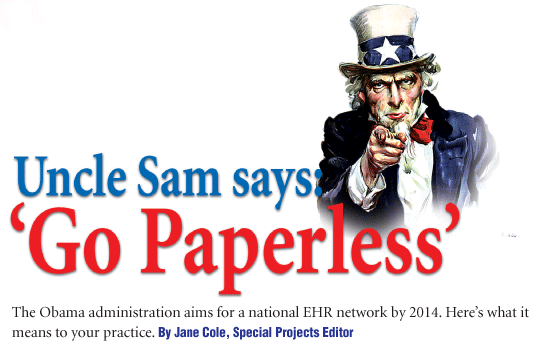
If you havent gone paperless yet, the days of handheld patient chartsto jot down your patients glaucoma progress, contact lens history or a reminder about Little Johnnys birthdaymay soon be a memory. That is, if the federal government is successful in its intensive push for a nationwide electronic health record system by 2014.
In February, President Barack Obama signed the American Recovery and Reinvestment Act of 2009 (ARRA) that committed $19 billion in federal stimulus funds to promote the adoption and use of health information technology (HIT) and specifically, electronic health records (EHR). To up the ante for physicians and hospitals to go paperless, the initiative includes financial incentives for those who comply and reimbursement penalties for those who dont.
Maximum benefits are earned if a certified EHR system is deployed early, so optometrists really should begin working on the project now, says practice management consultant Neil Gailmard, O.D., M.B.A., of
While not a federal mandate, the move to EHR is a key part of the new administrations health care agenda. The health care industry has been slow to adopt EMR (EHR), and new regulations are calling for this technology to be implemented within just a few years, says
Whether you have gone paperless, are thinking about it or have no plans to give up your paper records, this initiative will affect your practice. Heres a roadmap to help you navigate through the red tape.
Top 10 Questions to Consider Before Buying an EHR System
How strong is the company that produces the software? Will it be around in 10 years?
What kind of training programs does the vendor offer?
What are your colleagues using, and are they pleased with it?
Does the system include forms and records specifically for optical dispensing?
Can the user design customized exam templates?
Does exam data integrate with the practice management system (billing, recall, inventory management, etc.)?
Does the exam data integrate with a letter-writing program to easily produce report letters?
Does the program provide guidance for proper billing and coding?
Are there specific provisions for e-prescribing and PQRI coding?
By Neil Gailmard, O.D., M.B.A.
 How well does the software integrate with advanced diagnostic instrumentation?
How well does the software integrate with advanced diagnostic instrumentation?
A Nationwide IT Connection
For more than a decade, the federal government has called for a move away from antiquated paper records to a uniform network in which all physicians and hospitals would convert to a computerized patient record system. As a key component in its health care reform agenda, the current administrations goal is to have a fully connected nationwide health IT system by 2014. In fact, President Obama has publicly stated that every American will have the benefit of EHR by then.
The HIT components in the economic stimulus package, known as HITECH in the law, will improve patient safety and overall health, in addition to reducing national health care costs, according to the administration.
The Office of the National Coordinator of Health Information Technology (ONCHIT), within the U.S. Department of Health and Human Services (HHS), is guiding the federal policy on this initiative.
Health information technology has an impact on the practice of optometry in many ways, says Rodney Peele, AOA assistant director of regulatory policy and outreach. EHRs, including images, allow doctors to keep patient medical records in a secure, easily reviewed, electronic format, parts of which can be shared with other practitioners, health plans and public health agencies.
Specifically, electronic prescribing improves efficiency for patients and payers while minimizing risks from unintended interactions and misunderstood instructions, says Mr. Peele.
Electronic mechanisms to check a patients health plan benefits and to submit claims for services also improves the efficiency of optometric practice, he says. HIT also enhances communication with other physicians, improving care and the information in the patient record. Most doctors who implement HIT would never want to return to paper-based processes.
Financial Incentives
Essentially, the HIT initiative uses a carrot-and-stick approach of rewards for compliance and penalties for those who do not comply. The rewards come in the form of increased Medicare and Medicaid reimbursements for those who adopt EHR technology within the required timeframe.
Medicare Incentives
Beginning in 2011, eligible professionals who are meaningful users (see Many Gray Areas below for further information on meaningful users) of EHRs may receive up to $44,000 of Medicare payment incentives over a five-year period (up to $18,000, $12,000, $8,000, $4,000 and $2,000 in years one to five, respectively).
EHR users can also qualify for an additional $20,000 through the E-Prescribing and Physician Quality Reporting Initiatives.
Payments are made over time through Medicare and the O.D. must be a participating provider.
Those who practice predominantly in health professional shortage areas may receive up to 10% more.
Eligible professionals who become meaningful EHR users after 2012 receive reduced incentives, and those who wait until 2015 to first become meaningful EHR users receive no incentives at all. No incentive payments will be made after 2016.
Medicaid Incentives
For physicians with high volumes of Medicaid patients (30% or higher), the law provides subsidies through the Medicaid programs.
Under the legislation, the federal government would cover 100% of the costs for EHR-related Medicaid incentive payments made to Medicaid providers and 90% of the related state administrative costs.
For qualifying health professionals, these incentive payments would equal up to 85% of the net average allowable costs for adoption and operation of EHR technology (including related maintenance and training).
Doctors must choose whether to participate in the Medicaid or Medicare bonus programthey cant receive awards from both.
If you include hardware upgrades, facilities upgrades, training and all the other ancillary costs that go into adopting EMR, the incentives will probably not be enough (to cover the cost), Dr. Diecidue says. But, in the long-term, the cost savings should offset much of the initial expense.
Benefits of EHR
Better records because they are more thorough and more legible.
Reduction of medical errors by entering data less often and system checks that procedures are complete.
Fewer lost records.
Copies of records are easily produced or transferred.
Better communication between health care practitioners because letters are easy to generate.
No paper and file supply cost.
Less staff handling of paper records results in efficiency.
Less office space needed for record storage.
Exams will be faster after the EHR system is fully integrated into the practice because recording time is reduced.
Since EHR is still a fairly new concept for most optometric practices, patients will be impressed when they see doctors and staff using them. It creates a perception of being high tech and cutting edge.
By Neil Gailmard, O.D., M.B.A.
 Proper coding of exams results in higher revenue.
Proper coding of exams results in higher revenue.
Penalties
Physicians who fail to become meaningful EHR users by 2015 will be subject to Medicare payment reductions under the physician fee schedule.
For 2015, 2016 and 2017, payment will be set at 99%, 98% and 97%, respectively, of the otherwise applicable Medicare fee schedule amount (or at 98% in 2015 for physicians who are not e-prescribing), Mr. Peele says.
After 2017, HHS may lower reimbursement to 95% of the fee schedule if less than 75% of eligible professionals have become meaningful EHR users.
The HHS Secretary may also make case-by-case exceptions to the penalties if they would result in a significant hardship, such as in the case of an eligible professional who practices in a rural area without sufficient Internet access, Mr. Peele says. No one may qualify for an exception for more than five years, he adds.
Many Gray Areas
Although the HIT initiative is a done deal, several critical components still need to be defined. For example, to qualify for incentives, physicians need to be meaningful users.
In June, the Office of the National Coordinator for Health Information Technology (ONC) released its preliminary definition of meaningful users. The definition for achieving meaningful use of health data includes three parts: data capture and sharing by 2011, advanced clinical processes by 2013 and improved outcomes by 2015. The criteria for 2011 objectives and measures include capturing data in coded format; managing populations, such as generating a list of patients by specific conditions and sending patient reminders; improving care coordination, such as exchanging clinical information among providers, and performing medication reconciliation.
Initially, optometrists werent even considered in the legislation, but AOA advocacy efforts assured the inclusion of optometrists in the final law, Mr. Peele says. When it was introduced, O.D.s were not included in the Medicare or Medicaid HIT incentives. The AOA worked to ensure the language changed so its members are now eligible, Mr. Peele says.
The next step is making it practical and possible for O.D.s to participate, he adds. We will continue to advocate for policies that will allow O.D.s to demonstrate that they are meaningful users meriting maximum reimbursement, and we have been working with ophthalmology to obtain a necessary certification process for eye care EHRs, Mr. Peele says. The AOA Health Information Technology & Telemedicine Committee is developing a plan to urgently educate members about becoming meaningful users, he adds. HHS is expected to issue a final decision on meaningful users later this year.
In addition to the still undefined meaningful users, another gray area is: If an optometrist already has an EHR system, can he or she qualify for incentives? We do not yet know whether an optometrist who already uses EHR technology will be considered in compliance for the incentives, but its doubtful, Mr. Peele says. The law requires doctors to use certified EHRs to be able to receive the incentives. Eye care EHRs do not have a certification available, although the AOA and other eye care provider associations are trying to get this issue fixed in time for [the Recovery Acts] funding availability. Some optometrists might have obtained a certified general medical product and modified it for use in optometry practice, but we dont yet know if this will suffice for the stimulus bill.
ONCHIT expects to draft some EHR standards this summer, but there will be a lengthy internal clearance process. The AOA anticipates this initial set of standards to be published before Christmas, Mr. Peele says. The AOA is working with other eye care professional organizations to facilitate certification for eye care EHRs, he says. Meanwhile, the AOA will continue to communicate with federal policymakers about the requirements for meaningful use and the steps required to obtain an HIT reimbursement.
Although these gray areas (including the software certification standard) still exist, O.D.s shouldnt wait to purchase EHR systems, Dr. Gailmard advises. Some optometrists feel the need to wait until the software programs have been officially approved, but there is really no advantage in waiting. The process of analyzing systems, installing software and hardware, training and implementing is time consuming and challenging, Dr. Gailmard says. Those who wait may easily miss out on the maximum incentives, which require installation no later than 2011.
Decoding a HIT List of Acronyms
Health information technology consists of an alphabet soup of acronyms. Heres a translation:
ARRA: The American Recover and Reinvestment Act of 2009. President Barack Obama signed this economic stimulus legislation in February.
CCHIT: Certification Commission for Healthcare Information Technology. CCHIT is expected to be selected as the organization to set the certification standards for EHR software. CCHIT, a non-profit independent organization, is already the certification authority for in-patient and ambulatory EHRs.
HIT: Health information technology. The federal government has committed $19 billion to promote the adoption of HIT.
ONCHIT: Office of the National Coordinator for Health Information Technology. ONCHIT is under the U.S. Department of Health and Human Services (HHS) and is the principal federal entity charged with coordination of nationwide efforts related to the implementation and use of electronic health information exchange.
 HITECH: The Health Information Technology for Economic and Clinical Health Act is the HIT component of the ARRA stimulus package. The administration believes it is essential to improve the health care system and health care for Americans.
HITECH: The Health Information Technology for Economic and Clinical Health Act is the HIT component of the ARRA stimulus package. The administration believes it is essential to improve the health care system and health care for Americans.
EHR Vendors
While the actual software requirements for optometry and ophthalmology still need to be developed, major EHR vendors in eye care are pledging that their products will receive certification once the standards are released, Dr. Gailmard says. Meanwhile, doctors should ask their software supplier about efforts to be in compliance, he adds.
A leading optometric EHR provider, Eyefinity/OfficeMate, says it is 100% committed to ensuring that its software, ExamWRITER, complies with the new federal government certification standards, says company Chief Operating Officer C. Edward Buffington.
Its not an option for us, Mr. Buffington says. He adds that the federal initiative is positive for eye care and health care as a whole. It is good for the industry, for patients and the profession. This will create a standard for patient information exchange across all disciplines, and it will streamline the whole process of patient care.
Eyefinity/OfficeMate currently has a dedicated Q&A page and an upcoming blog on its website to educate doctors about the HITECH Act and the status of certification, in addition to other marketing efforts to help educate current and prospective clients. Under the Stimulus Plan, there are significant dollars available, and we want to be sure our doctors can take full advantage of this, Mr. Buffington says. While new certification standards for eye care specialties have not been released, Eyefinity/OfficeMate is focusing on the current CCHIT (Certification Commission for Healthcare Information Technology) ambulatory specialties, he says.
Meanwhile, the new HIT initiative is sparking a heightened interest for O.D.s to purchase EHR systems. This is partly due to the federal incentives, but also due to a general awareness that the benefits of EHR far outweigh the drawbacks, Dr. Gailmard says. Most O.D.s know they need to move to EHR eventually. Up until now, it was easy to procrastinate and not take action because of the initial software expense and the staff training. But, the incentive payments are definitely making optometrists wake up and take notice.
Subsequently, companies are also taking notice of heightened interest and opportunities for EHR. For example, the national wholesale outlet Sams Club is offering a bundled EHR system-including software, hardware and technical supportin three test pilot states.
Despite the new administrations push for a nationwide electronic health care record system, the sell could be an uphill battle. A recent study published in the New England Journal of Medicine reported that only 1.5% of U.S. hospitals have a comprehensive electronic records system and just another 8% to 11% have a basic system in place.1 Findings of the survey suggest that policymakers face substantial obstacles to the achievement of health care performance goals that depend on health information technology, study researchers reported.
Still, the benefits of EHR, and the financial repercussions of not complying with the new federal HIT initiative, may be the impetus needed to convert those physicians still holding onto their paper records.
(With EHR), patient records will be cleaner, more complete and compliant, e-claims will go through cleaner and faster, and costly mistakes (both to the practice and to the patients) will be avoided or minimized at the least, Dr. Diecidue says. Of course, compliance with federal regulations is the big benefit. There will come a time when NOT having an EMR will cost you in penalties."
A Q&A with the AOA
Q: What does the AOA recommend for optometrists?
A: The AOA policy is not to endorse a particular HIT product.
Q: Does the AOA have information about HIT incentives online?
A: Yes, See
http://www.aoa.org/HIT.xml for information for members.
The AOA will update this information when the ARRA incentives are available.
Q: Does the AOA have a plan for optometrists to become meaningful users of certified HIT?
Q: What should optometrists do now?
A: Optometrists should investigate available EHRs and the implementation timeline/requirements in their practices. Doctors and staff will need time to begin using these products and efficiently utilize them in the practices workflow.
Source: Rodney Peele, AOA
 A: Yes, the AOA Health Information Technology and Telemedicine Committee is developing a plan to educate members and assist in the implementation and use of certified HIT.
A: Yes, the AOA Health Information Technology and Telemedicine Committee is developing a plan to educate members and assist in the implementation and use of certified HIT.
1. Jha AK, DesRoches CM, Campbell EG, et al. Use of electronic health records in

